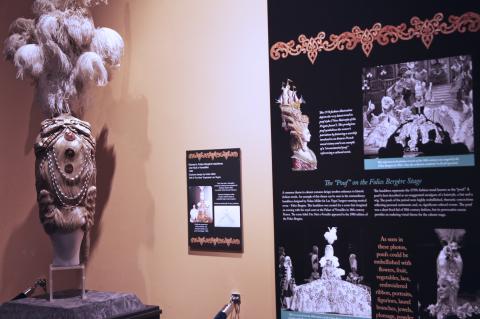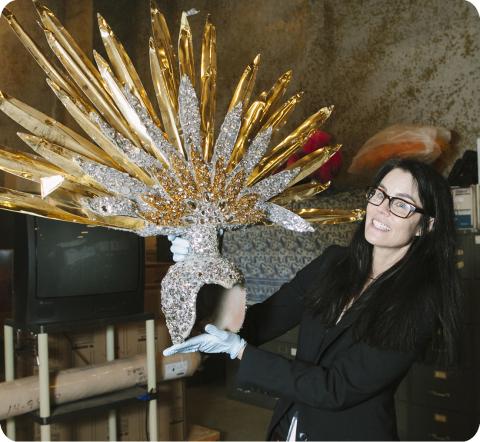
Our Researcher Profile series highlights researchers and who have used resources in Special Collections & Archives for a variety of projects ranging from articles and books to exhibits and documentaries and more.
This post focuses on the work of Karan Feder, Guest Curator of Costume & Textiles, at the Nevada State Museum, Las Vegas and author of The Folies Bergere in Las Vegas (Arcadia, 2017).
Tell us a little bit about the project (book, exhibit, article, documentary, report) you researched in Special Collections & Archives.
Les Folies Bergère: Entertaining Las Vegas, One Rhinestone at a Time explored the beauty, artistry, and extravagance of Vegas' longest running Parisian cabaret show. Included in the exhibit were rarely seen photographs, ephemera, and spectacular stage costumes from the archives at the Las Vegas News Bureau, UNLV Libraries Special Collections, and the Nevada State Museum, Las Vegas. The unique exhibition interpreted the legacy of the stage show via the personal narratives of those individuals who brought life to Las Vegas' Folies Bergère. The exhibition showcased the State Museum's recent acquisition of the entire existing Folies Bergère costume archive discovered backstage at the Hotel Tropicana.
How did you hear about Special Collections & Archives?
I specifically heard about Special Collections’ acquisition of the Jerry Jackson Collection from Su Kim Chung during a public program she was involved with. [Editor's note - the entire Jerry Jackson Collection is now available online]
What resources, collections or materials from Special Collections & Archives were most impactful for your research?
I referenced the Library’s Jerry Jackson Collection and the Folies Bergere collection. (Jerry Jackson was involved with the Folies Bergere production for many decades and his indispensable contributions encompassed a broad range of disciplines.)
How did you become interested in the topic(s) you wrote about?
I am serving as the Guest Curator of Costume & Textiles at the Nevada State Museum, Las Vegas. My Folies Bergere research project resulted from the Nevada State Museum’s once-in-a-lifetime acquisition of the entire surviving costume stock from the Hotel Tropicana’s Folies Bergere stage production. The significant donation includes more than 8,000 pieces and spans a 50-year period.
The Folies Bergere archive arrived at the Nevada State Museum in sky-high piles, boxes, and bags over the course of a few days in January of 2015. As is the case with most museum donations, the collection was entirely un-cataloged, un-inventoried, and un-deniably unorganized. As I was the curator responsible for making sense of the archive and an individual whom never had the pleasure of viewing a performance of the stage show, it was necessary to identify extant research collections to assist in not only the identification of the material in the donation but to aid with interpretation of the that material.

What surprised you the most about your research in Special Collections & Archives?
I was thrilled to discover that the Jerry Jackson Collection even included a few 3-dimensional objects.
What advice would you give to other authors/researchers using Special Collections & Archives? (Otherwise known as what I wish someone had told me before I visited Special Collections & Archives)
Allow sufficient time for Library staff to pull the research material from storage and set aside more time than you think you’ll need to peruse the material.
How did your research in Special Collections & Archives change your perceptions about Las Vegas?
UNLV’s Special Collections & Archives offered further acknowledgement and understanding of Las Vegas’ unique cabaret legacy. During the mid-20th century, folks moved to Las Vegas from all over the world to work with these spectacular productions. These "show people" settled in Vegas, raised families, and ultimately established ancillary businesses. These entrepreneurial and independent personalities were the City's modern settlers and chartered the eccentric character of today's Las Vegas.
What are you working on next?
Resulting from the Nevada State Museum, Las Vegas’ recent acquisition of the original costume design artworks of Pete Menefee, I am currently studying and researching the legacy of the Jubilee stage show that appeared at MGM Grand/Bally’s Las Vegas for a 35-year run.
If you are from out of town, what other places did you visit (could be other sites for research, restaurants, etc.)
I reside in Vegas.
What is the biggest challenge you faced while working on your project?
The daunting task was getting up to speed concerning the history of the Folies Bergere in both Paris and Las Vegas. A crucial concern was the identification the show’s visual identity and visual timeline.
What advice would you give other exhibit designers?
One might assume that the visually spectacular and exciting costumes of the cabaret genre speak for themselves in an exhibition. But I suggest that the researcher goes the extra mile to identify the underlying narratives of the actual folks who worked with these performance costumes; find the life in the inanimate.


